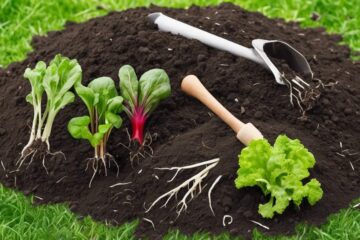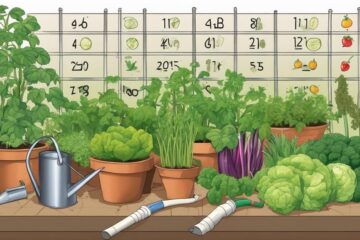Spring signals the splendid season for sowing a selection of sensational spring vegetables like asparagus, snap peas, arugula, sorrel, and Swiss chard. But did you know that planting these veggies at the right time can significantly impact their growth and flavor?
Explore the optimal planting schedules and essential seasonal considerations to ensure a bountiful harvest of these delectable delights.
Stay tuned for expert tips on maximizing the growth of these top spring vegetables and a comprehensive seasonal planting guide to elevate your spring gardening game.
Best Vegetables to Plant in Spring
When planning your spring garden, it’s essential to choose vegetables that not only thrive in the season but also enrich your meals with fresh flavors and nutritional benefits. Early spring is the perfect time to sow seeds for peas, spring onions, and baby carrots. These cool-weather lovers are not just easy to grow; they also promise a delicious and crunchy addition to your spring meals.
In addition to these staples, incorporating spinach into your garden can elevate your salads and dishes with its nutrient-dense leaves. Spinach is particularly rewarding to grow in spring, as it flourishes in cooler temperatures and can be harvested relatively quickly.
For gardeners looking to diversify their vegetable patch, fava beans and snow peas are excellent choices. These legumes not only add variety to your culinary creations but also to your garden’s ecosystem. They’re known for their ability to fix nitrogen in the soil, improving its fertility for future plantings.
To ensure the success of your spring vegetable garden, remember the importance of providing your plants with enough sunlight and planting them in well-draining soil. These conditions are crucial for the optimal growth of your spring vegetables, setting the stage for a bountiful and flavorful harvest.
By selecting the right mix of vegetables and providing the appropriate care, your spring garden can become a source of culinary inspiration and a testament to the joys of home gardening.
Following these planting tips will set you on the path to a successful spring harvest.
Planting Schedules and Seasonal Considerations
As you plan your spring vegetable garden, understanding your local planting schedule and considering seasonal factors such as temperature and sunlight are essential for a successful harvest.
Spring vegetables each have their own preferred planting windows, which are often determined by their tolerance to cold and their growth cycle lengths. For instance, cool weather crops such as sugar snap peas thrive when planted after the last frost date, leveraging the mild temperatures of early spring to establish themselves.
Here’s a concise guide to help you navigate these considerations:
Planting Schedule and Seasonal Considerations
- After Last Frost Date: This time is ideal for sowing seeds of cool weather vegetables like sugar snap peas, spinach, and lettuce. These crops can endure the cool temperatures of early spring and even benefit from them, leading to a more flavorful harvest.
- During Warmer Weather: As spring progresses and temperatures begin to rise, it’s the perfect time to plant vegetables that prefer a bit more warmth, such as tomatoes, cucumbers, and beans. These should be planted only after the threat of frost has passed, and the soil has warmed sufficiently.
It’s crucial to stay informed about your local climate’s last frost date and monitor soil temperatures to optimize your planting schedule. The goal is to allow your spring vegetables to mature fully before the arrival of summer’s heat, which can stress plants and affect yields.
Incorporating these planting schedules and seasonal considerations into your garden planning will not only ensure that your vegetables are planted at the optimal time but also help in maximizing the productivity and health of your garden. By carefully timing your plantings based on these guidelines, you can enjoy a diverse and continuous harvest throughout the spring and into summer.
To further tailor your planting strategy, consult local gardening resources or extension services for specific advice related to your region’s climate and soil conditions. This localized guidance can be invaluable in creating a planting calendar that suits your garden’s exact needs.
Spring Vegetable Gardening Tips
To enhance the health and yield of your spring vegetable garden, prioritize soil preparation with essential nutrients. Here are some tips to help you cultivate vibrant and high-quality spring vegetables:
1. Soil Preparation and Nutrient Enrichment
- Start with the Soil: Enrich your garden soil with compost or well-rotted manure to provide essential nutrients. Testing your soil can help you understand its needs, whether it’s more nitrogen for leafy greens or potassium for fruiting plants.
- Early Planting: Sow seeds of early spring vegetables like pea shoots and wild leeks as soon as the soil is workable. These early starters benefit from the cool temperatures of spring and can lead to an early and bountiful harvest.
2. Mulching for Moisture and Temperature Control
- Apply Mulch: A layer of organic mulch can help retain soil moisture, suppress weeds, and regulate soil temperature. Materials such as straw, grass clippings, or shredded leaves are effective and can add to the soil’s nutrient content as they decompose.
3. Regular Pest Monitoring
- Vigilance Against Pests: Keep a close eye on your plants for signs of pests. Early detection and intervention can prevent significant damage. Natural remedies and barriers, like netting or row covers, can protect your crops without the need for chemical interventions.
4. Consistent Watering
- Water Wisely: Spring vegetables need consistent moisture to thrive, especially as they establish roots and grow. Water deeply and less frequently to encourage deep root development. Early morning watering reduces evaporation and minimizes disease risks.
5. Additional Considerations
- Spacing and Thinning: Proper spacing and thinning of seedlings are crucial to prevent overcrowding, which can lead to competition for nutrients and increased susceptibility to diseases.
- Succession Planting: To extend your harvest, consider succession planting. Planting seeds at intervals allows for a continuous supply of vegetables rather than a single, overwhelming harvest.
By implementing these tips, you can look forward to a productive and enjoyable spring gardening season. The key is to observe and respond to the garden’s needs promptly, ensuring your spring vegetables receive the best possible care from planting to harvest.
Maximizing Spring Vegetable Growth
Maximizing the growth and health of your spring vegetables involves a series of strategic cultivation practices that together create an environment conducive to vibrant and robust plant development. Let’s delve into these practices and their benefits, providing a holistic approach to achieving an abundant spring garden.
Strategic Cultivation Practices for Spring Vegetables
1. Proper Soil Preparation
- Foundation for Healthy Growth: Begin with enriching your soil. Incorporate organic matter such as compost or well-rotted manure to improve soil fertility and structure. This creates a nutrient-rich foundation that supports root growth and vegetable health.
2. Mulching for Moisture Retention
- Moisture Control and Weed Suppression: Applying mulch around your plants helps maintain soil moisture, reduces weed competition, and keeps root temperatures stable. Organic mulches, like straw or leaf mold, also gradually add nutrients back into the soil as they decompose.
3. Regular and Efficient Watering
- Ensuring Plant Vitality: Consistent watering, especially during dry spells, is crucial for the development of spring vegetables. Water deeply to encourage deep root systems, which are more drought-resistant and capable of accessing nutrients from deeper soil layers.
4. Vigilant Pest Control
- Protecting Your Harvest: Regularly inspect your plants for signs of pests and diseases. Early detection and natural control methods can prevent infestations from compromising your garden’s yield.
5. Timely Harvesting
- Maximizing Flavor and Nutrient Content: Harvesting your vegetables at the right time ensures the best flavor and nutritional value. Understanding the peak maturity of each vegetable type allows you to enjoy the fruits of your labor at their finest.
6. Spring Fertilizing
- Boosting Growth and Productivity: A balanced, slow-release fertilizer applied in spring can provide essential nutrients that support leafy growth and fruit development. This is particularly beneficial for nutrient-hungry crops like beets and cucumbers.
7. Soil Enrichment with Compost
- Sustainable Gardening Practices: Incorporating compost made from plant debris not only recycles garden waste but also enhances soil structure and fertility. This sustainable practice supports healthier plant growth and reduces the need for chemical fertilizers
Seasonal Planting Guide for Spring
For successful spring planting, focus on selecting the right vegetables that thrive in the season’s optimal growing conditions. When planning your spring garden, consider the following essential vegetables to plant:
- Peas: These legumes love the cool temperatures of spring and are great for adding to salads or enjoying as a snack.
- Spinach: Packed with nutrients, spinach thrives in the spring and can be harvested for delicious salads or cooked dishes.
- Lettuce: Plant various types of lettuce for a continuous harvest throughout the spring season.
- Radishes: Quick to mature, radishes add a pop of color and flavor to your spring dishes.
Frequently Asked Questions
What Are the Most Popular Spring Vegetables?
When spring arrives, you’ll love the popular veggies like asparagus, peas, artichokes, arugula, and carrots. They add a burst of freshness to your meals and are best enjoyed when they’re in season.
What Veggies Are in Season for Spring?
In spring, enjoy the sweetest snap peas, flavorful arugula, tangy sorrel, and the ultimate asparagus varieties. Swiss chard adds color and versatility to your dishes. Embrace these seasonal veggies for a fresh culinary experience.
What Are the Best Spring Vegetables to Buy?
For the best spring vegetables to buy, choose nutrient-packed options like peas, spinach, and beets. These colorful veggies not only taste great but also provide essential vitamins and minerals for your health. Enjoy the bounty of the season!
What Is the Best Vegetable to Plant in Spring?
For the best vegetable to plant in spring, consider factors like taste, growth speed, and care needed. Peas stand out for their sweetness and ease of growth. Planting them early can lead to a satisfying harvest.
Conclusion
So, as you enjoy the fresh flavors of spring vegetables like asparagus, snap peas, arugula, sorrel, and Swiss chard in your meals, remember to keep planting and tending to your garden.
With a little care and attention, your garden will flourish and provide you with an abundance of colorful and nutritious produce.
Just like the vibrant colors of a rainbow, your spring vegetable garden will bring joy and satisfaction to your plate.
Happy planting!





